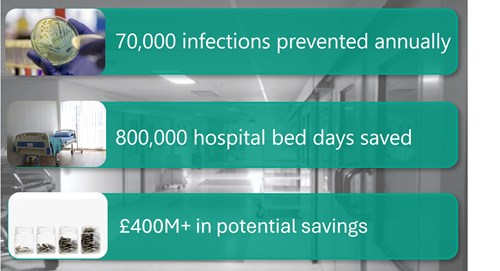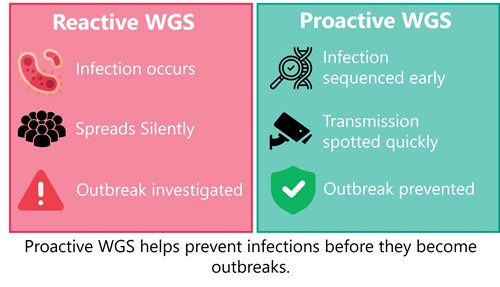
Sign in to access your HIS profile below.
Did you know proactive Whole Genome Sequencing (WGS) could prevent more than 70,000 healthcare-associated infections and free up to 800,000 hospital bed days each year in England alone?
 What’s more, this could be achieved by working with existing processes - and it could save money at the same time.
What’s more, this could be achieved by working with existing processes - and it could save money at the same time.
Proactive WGS involves sequencing infections as they occur, rather than waiting for an outbreak. This allows transmission patterns to be identified in real time, helping Infection Prevention and Control (IPC) teams spot outbreaks earlier, intervene faster, and prevent further spread.
The current situation
According to the latest point prevalence survey, healthcare-associated infections (HCAIs) affect up to 8% of admitted patients—up from 6.8% in the previous survey. Not all HCAIs are preventable, but we should be doing everything we can to avoid the ones that are.
A notable share of HCAIs is caused by antimicrobial-resistant (AMR) pathogens—an escalating threat. Recent forecasts suggest that by 2050, bacterial AMR could directly cause nearly 2 million deaths globally each year and contribute to over 8 million more. Although highly resistant isolates are easier to track, they are also harder to treat. Their more susceptible counterparts, while less often studied, can spread in similar ways and pose equally serious risks to patients.
These infections contribute to morbidity and mortality, often leading to extended hospital stays. In addition to the human toll, they drive up healthcare costs and create further economic burdens for patients and families. They also impact resource utilisation, placing additional pressure on already stretched healthcare systems—and can even affect the workforce through exposure and illness.
And that’s just the beginning. HCAIs are also associated with:
What has changed
 Historically, use of WGS has been largely reactive - used to investigate pathogens after an issue has already been identified. While proactive sequencing has shown promise on a small scale, wider adoption has been limited by the challenge of scaling delivery without substantial local expertise.
Historically, use of WGS has been largely reactive - used to investigate pathogens after an issue has already been identified. While proactive sequencing has shown promise on a small scale, wider adoption has been limited by the challenge of scaling delivery without substantial local expertise.
That is now changing. The cost of sequencing is falling, and technical barriers are being removed. At the same time, a growing body of evidence demonstrates that proactive WGS is both feasible and cost-effective. Real-world examples and modelling suggest that genomic surveillance can reduce infections, improve patient outcomes, lower costs, and free up bed days. Insight 5 from our Insight Series summarises some of the emerging evidence around cost-effectiveness and impact.
One of the main obstacles to routine use of WGS has been the bioinformatics burden. Sequencing generates large volumes of data, traditionally requiring high-performance computing and specialist interpretation. Even with trained bioinformaticians, it has been difficult to process data beyond a few months at a time, and incorporating new samples often meant repeating previous analyses. This made WGS impractical for most clinical microbiology laboratories.
That landscape is shifting. Advances in sequencing platforms and data analysis tools have removed the need for dedicated local bioinformatics support. Clinical teams can now run real-time, large-scale genomic surveillance without complex pipelines or reprocessing - making proactive WGS viable for routine use.
Importantly, WGS can now be performed in standard clinical microbiology labs - much like PCR. It wasn’t long ago that PCR was reserved for reference centres, but today it’s standard in nearly every lab in the UK. WGS is following the same path. With technical barriers coming down, genomic surveillance is becoming a practical, everyday tool for infection prevention.
Prevention is better than cure
This principle has never been more relevant. With healthcare-associated infections on the rise, antimicrobial resistance approaching crisis levels, and the effects of long-term underfunding becoming increasingly clear, prioritising prevention is no longer optional - it’s essential.
Timely intervention and proactive action are key to protecting patients and securing the future of healthcare. The time to act is now - delay is not a viable option.
Genpax is helping to enable wider access to WGS analysis. Our IDEM platform is designed to help healthcare professionals stop infections before they spread - strengthening prevention through earlier insight.
We’re committed to making high-quality, actionable pathogen analysis accessible to healthcare institutions of all sizes. Founded by Dr Nigel Saunders, a leading medical microbiologist and genomics expert, Genpax developed IDEM to address the barriers that have historically limited routine WGS adoption in clinical settings.
Professor David Livermore notes:
 "Genpax's IDEM platform brings a new level of accuracy to sequence analysis, and therefore a new level of precision to the investigations of outbreaks and antibiotic resistance."
"Genpax's IDEM platform brings a new level of accuracy to sequence analysis, and therefore a new level of precision to the investigations of outbreaks and antibiotic resistance."Health Economic Impact of Proactive WGS
Proactive WGS offers not only clinical benefits but also significant economic advantages. Health economic modelling shows that the NHS in England could save over £450 million annually by adopting a WGS-led strategy. For every £1 invested, the potential return could exceed £7.
For an average 800-bed hospital, this could translate to more than £2 million in annual savings and the prevention of over 400 infections each year. This aligns closely with NHS priorities - driving quality improvement while delivering measurable cost efficiencies and better outcomes for patients.

Professor Jon Cohen, writes:
IDEM features intuitive dashboards for IPC teams, providing clear, actionable insights to support timely intervention.


At Genpax, we’re partnering with healthcare institutions to demonstrate the transformative impact of proactive WGS. Together, we can shape practical workflows and guidelines that fully integrate genomic surveillance into everyday infection prevention strategies.
To support early adopters, we’re offering mini grants to members of the HIS community for local pilot projects using the IDEM platform. These grants offer the chance to trial WGS in practice and explore its integration into existing IPC workflows.
Look out for upcoming online seminars, where we’ll introduce IDEM and discuss its practical use in clinical settings.
If you'd like to learn more, please feel free to contact us at info@genpax.co. For additional resources, explore our Insight Series, where you can find summaries of current evidence and guidance.
Together, we can make a lasting impact in the fight against HCAIs and AMR - bringing IPC into the genomic era, improving care for patients across the UK.